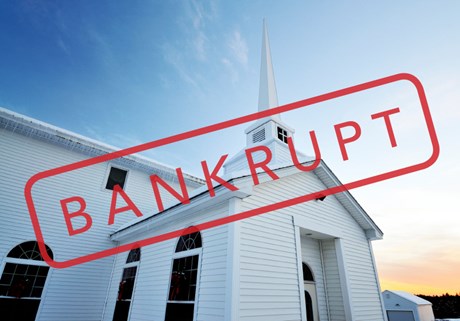CT: The Surprise Inside Church Bankruptcies
It’s not that they owe more than they own, says Pamela Foohey. It’s a leadership failure.
[ posted 11/12/2013 9:57AM ]

After its revenues plunged from $55 million to $25 million over three years, in 2010 the Crystal Cathedral filed for protection under Chapter 11 of the federal bankruptcy code. They weren't alone: nearly 500 others did over a five-year period. University of Illinois law professor Pamela Foohey took a closer look at church bankruptcy filings from 2006-11 and continues to track them. Her study, "Bankrupting the Faith," is forthcoming in the Missouri Law Review.) She was interviewed by Ken Walker, who wrote today's article on the effects of so many church bankruptcies.
What motivated you to take a closer look at church filings?
I decided to hone in on religious organizations' use of bankruptcy law. They occupy a distinct place in our society and have a distinct mission, which I thought would be useful to explore.
You mention religious organizations and small businesses have some of the same vulnerabilities. Are there any ways churches use Chapter 11 differently?
They're much different when they enter Chapter 11. They come into bankruptcy owning a larger church building, but the amount outstanding on the mortgage is less than the building's value. The fact that they have a significant asset and own part of it makes them distinct from small businesses.
You say that leadership helps determine the viability of a financially troubled church. Is that any different than a small business?
Many times churches using Chapter 11 are only going to succeed if a dynamic leader is part of the church and does what he does to make the church a viable business—to revitalize the membership or work to change what the church is doing so there is a better revenue stream. So in that way they're very similar.
Did you observe any structural weaknesses of churches?
That has to do with why they're in bankruptcy—the church purchased a building that onlylooked like a good deal. The structural weakness might be looking ahead enough at how the church and its members are going to pay the mortgage. That's what I call a leadership failure in terms of not looking into the future about what is, essentially, the church's business model.
Any particular findings that surprised you?
What surprised me the most was that churches entered bankruptcy saying they owned a building that was worth significantly more than they owed on it: an "equity cushion." Most businesses that enter Chapter 11 are hopelessly insolvent; they have debts three times what they own. Churches look a lot different. I was surprised to find that so many churches had a healthy asset vs. debt profile. Because of that, I was also surprised that they were in Chapter 11. I would have thought that there would be an incentive on the part of the mortgage holders, the banks, to try to come to a deal.
You say that 72 percent of church filers were balance-sheet solvent, but there is often a major difference between total assets and liquidity.
That's part of why I was surprised they were filing. Balance sheet solvent means a church that is filing may be saying say its church is going to be worth $2 million if they sold it at market value. But the minute you try to sell a church at an auction, the value drops a lot. So the usefulness of the code is to allow the church to hang on and realize the market value of the property (and) the plan is confirmed by the bank. And obviously leaders and members are happy they get to stay in the place where they've been worshiping.
No comments:
Post a Comment